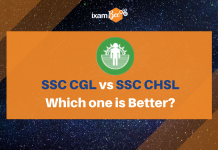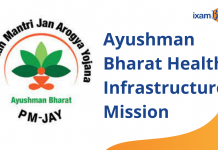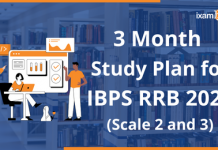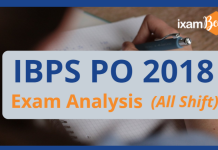The recruitment process for the RBI Grade B Exam 2023 is approaching its end. Aspirants who are about to appear for the RBI Grade B exam next year are all set with all their heart and soul dedicated to their preparation for the RBI Grade B exam 2024. It is important to understand that the level of difficulty is uncertain for any RBI Grade B Exam. If you want to make yourself immune to every kind of question, solving questions is not going to help you. First things first, you are required to have a clear understanding of the RBI Grade B syllabus.
There are various posts under the RBI Grade B scale, like DSIM, DEPR, etc. There are various sections you will find in the syllabus and exam pattern of the RBI Grade B Exam. You must be familiar with the syllabus of the RBI grade B exam before heading any further with the examination. If you are someone who has a zest for becoming an RBI Grade B officer, then you must already be aware of the syllabus of this exam till now.
A Common Mistake Every Aspirant Makes in the Preparation Process
There are three phases of the RBI Grade B Exam: Prelims, Mains, and Interview. Many students make this mistake during their preparation journey. They prepare with the objective of cracking the exam instead of being an RBI Grade B Officer. If you prepare with the aim of being an RBI Grade B officer, your motivation level with touch heights, and as a result, you will end up preparing for the RBI Grade B. Many students limit themselves to preparing for the prelims exam only and wait to clear it once in order to start preparing for the Phase 2/Mains exam. Here, let us clarify that you will get the time of only a few weeks for the RBI Grade B Mains exam after the declaration of the Prelims exam result.
So, you should start preparing to become the RBI Grade B Officer in the 2024 batch before it gets too late. In that league, we at ixamBee believe in making you completely prepared for every difficulty level of the exam. However, the RBI Grade B Prelims exam is 100% descriptive, but the Mains exam is divided into sections, and the major challenge faced by aspirants is in the Descriptive section.
Descriptive section in RBI Grade B
The description section of the RBI Grade B is in the Mains exam. The section possesses: Economic and Social issues, and the other one is English Writing Skills. For once, a candidate might perform well in the objective section, but when it comes to the descriptive section, you are required to follow specific guidelines that will make you score.
In this blog, we are going to talk about the ESI (Economic Social Issues) Section of the RBI Grade B Mains Exam. How to attempt the descriptive part of it, and much more.
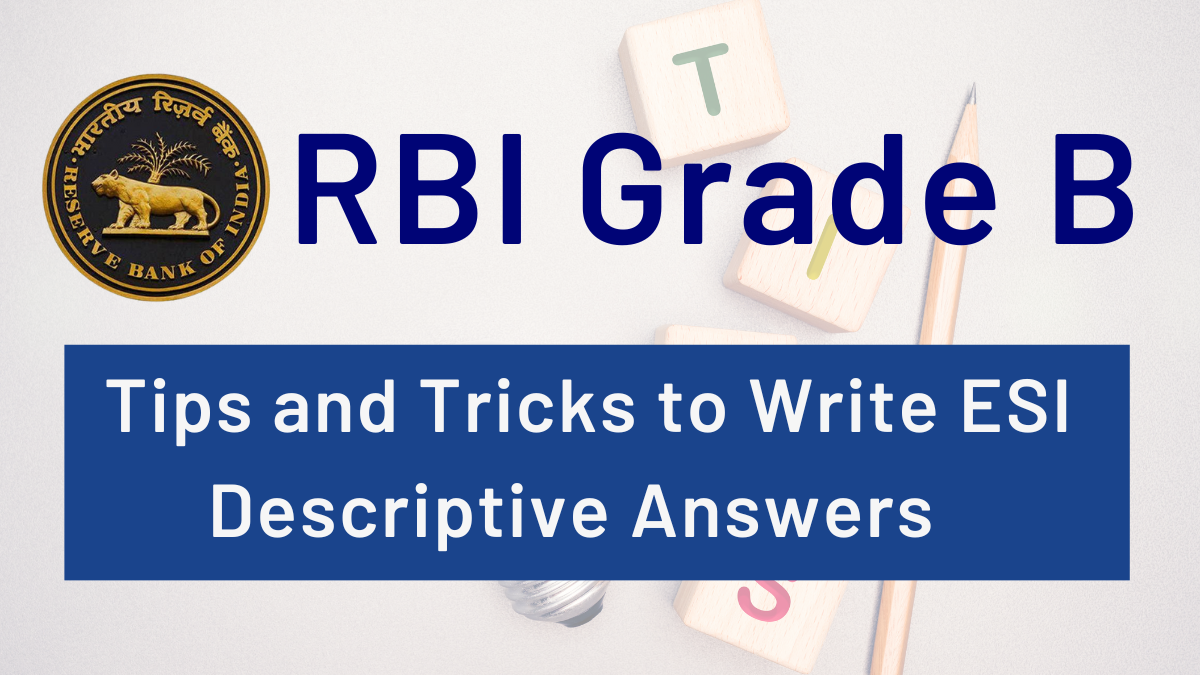
Economic and Social Issues in the RBI Grade B Mains
The change in the examination pattern has left a feeling of confusion and shock among the aspirants. Recognizable confusion for the descriptive papers of ESI & FM is spread on a clear-cut view among aspirants.
In this article, the tips to write descriptive paper in (ESI), the types of questions, where to study from and how to study the Economic & Social Issues descriptive papers of RBI Grade B 2024 are discussed.
What is descriptive writing?
Contrary to the name, descriptive writing is writing to the point. It can be better illustrated with a story. “Once there was a well-renowned Professor in economics. One day his assistant got a call from a Television channel asking him to deliver his comment on the current economic situation. The assistant asked him, “when shall I give the appointment?” The Professor enquired the assistant, “how long the session will go? If it is more than half an hour then I can deliver it now over the call but if I will get 5 minutes to talk then by tomorrow, I will be ready and if I only get a minute to say then I need a time till next week to prepare”.
The point is when you are writing for descriptive you have to stick to the point. The knowledge to impart is vast but the value of the words chosen plays a crucial role in descriptive writing. Writing for descriptive papers require a balance of good knowledge and the presentation skills.
Important Topics for ESI Descriptive Paper
Before 2016, RBI Grade B Phase 2 exam pattern had completely descriptive papers and now again 50% of the paper will be descriptive in nature. There is a topic of Human Development in the Social Structure of India unit of the Economic & Social Issues (ESI) syllabus for RBI Grade B Phase 2 exam. This topic is of major importance in RBI Grade B 2024 exam and many questions are expected from this section.
Human Development
The Human Development may be defined as an ‘expansion of human capabilities, a widening of choices, an enhancement of freedom, and a fulfillment of human right’. At the beginning, the notion of human development incorporates the need for income expansion. However, income growth should consider expansion of human capabilities. Hence development cannot be equated solely to income expansion. It is about expanding the richness of human life, rather than simply the richness of the economy in which the human beings live. Human development focuses on:
- People: Improving their lives, rather than assuming that economic growth will lead, automatically, to greater wellbeing for all.
- Opportunities: Giving people more freedom to live lives as per their values, developing their abilities and giving them a chance to use them.
- Choice: Providing people with opportunities, not insisting that they make use of them
Essential Pillars of Human Development
The noted Pakistani economist Mahbub ul Haq considered four essential pillars of human development.
- Equality (people must enjoy equitable access to opportunities)
If development is viewed in terms of enhancing people’s basic capabilities, people must enjoy equitable access to opportunities. Such may be called equality-related capabilities. To ensure equality-related capabilities or access to opportunities, the societal institutional structure needs to be progressive.
- Sustainability (desired balance between future economic growth and environmental quality)
Another important facet of human development is that development should ‘keep going’, and should ‘last long’. The concept of sustainable development focuses on the need to maintain the long-term protective capacity of the biosphere. This then suggests that growth cannot go on indefinitely; there are, of course, ‘limits to growth.’
- Productivity (Investment in human capital)
Another component of human development is productivity which requires investment in people. This is commonly called investment in human capital. Investment in human capital—in addition to physical capital—can add more productivity.
- Empowerment (Political democracy; people enjoy greater political and civil liberties and remain free from excessive controls and regulations of the state)
The empowerment of people-particularly women is another component of human development. In other words, genuine human development requires empowerment in all aspects of life. Empowerment implies a political democracy in which people themselves make the decisions about their lives.
Human Development Index
Per capita income does not stand as a true index of development of any country. To overcome this problem and to understand the dynamics of development, the United Nations Development Programme (UNDP) developed the concept of Human Development Index (HDI) in the 1990s. The Human Development Index (HDI) is a tool developed by the United Nations Development Programme (UNDP). It was introduced in the first Human Development Report in 1990. HDI is part of the Human Development Report which is published by UNDP every year. It measures and ranks a country’s level of social and economic development. The report was launched in 1990 by the Pakistani Economist Mahbub ul Haq and Indian Nobel laureate Amartya Sen. The HDI was created to emphasize that people and their capabilities should be the ultimate criteria for assessing the development of a country, not economic growth alone.
How Is the HDI Measured?
The HDI is a summary measurement of basic achievement levels in human development. The computed HDI of a country is an average of knowledge and understanding, a long and healthy life, and an acceptable standard of living. Each of the three components is normalized to scale between 0 and 1, and then the geometric mean of the three components is calculated.
Human Development Report
Human Development Reports (HDRs) have been released for most years since 1990 and have explored different themes through the human development approach. They have had an extensive influence on the development debate worldwide. The reports, produced by the Human Development Report Office for the United Nations Development Programme (UNDP), are ensured of editorial independence by the United Nations General Assembly.
Human Development Report 2021-22
The Human Development Report 2021-22 was released on September, 2022. The Title of the Report was “The next frontier: Human development and the Anthropocene”. The report covered 191 country. India ranked 131 (0.645) among 189 countries (medium human development category), with a PHDI value of 0.626.
In the 2021-22 Human Development Report, India ranks 132nd out of 191 countries, with the report titled “Uncertain Times, Unsettled Lives: Shaping our Future in a Transforming World.” The special report for 2022, titled ‘New Threats to Human Society in the Anthropocene,’ highlights global insecurities, even in the wealthiest nations. It discusses emerging threats like digital technologies, conflicts, inequalities, and healthcare system challenges, such as the COVID pandemic. The report emphasizes the link between declining trust and increased insecurities, as those feeling insecure are less likely to trust others.
PHDI (Planetary pressures–adjusted Human Development Index)
The Planetary pressures-adjusted Human Development Index (PHDI) is an experimental index that adjusts the Human Development Index (HDI) for planetary pressures in the Anthropocene. PHDI is HDI value adjusted by the level of carbon dioxide emissions and material footprint per capita to account for excessive human pressures on the planet. It illustrates the challenge of tackling poverty and inequality while easing planetary pressure. Also, it shows change in global development landscape if both wellbeing of the people and planet were central to defining humanity’s progress.
It is computed as the product of the HDI and (1 – index of planetary pressures) where (1 – index of planetary pressures) can be seen as an adjustment factor.
How to attempt a Descriptive ESI Paper?
The answer writing in descriptive questions must be to the point. If a question is asked on human development, then frame all the important points that need to be written. The important point to note is that in RBI Grade B 2024 exam, every question will be divided into sub-questions, and the word limit is approx. 250 words to 300 words.
Tips for Descriptive Writing
- Select the appropriate question. In the exam you will have choices and choose the one in which you are most comfortable.
- Develop a framework for the answer. After seeing the question take time and think how you will write the answer. Cover important points to mention and then frame accordingly.
- Write and revise
- Write to impress, but don’t overdo it. Anything more than required is always unnecessary, and nobody pays attention to it. Avoid unnecessary vocabulary and mention factual information.
- Strong beginning and conclusion in the last lines. Don’t forget to start and end with strong communication. Your answer must have a conclusive remark.
We hope that the above tips have cleared a bit in your mind regarding the writing structure of the ESI descriptive paper in the RBI Grade B Phase 2/Mains exam. If you want more clarity in writing the answers, then one on one guidance is the Ace of Spades for you. We at ixamBee provide an RBI Grade B Exclusive course that is designed by experts having years of experience in mentoring and working in the RBI. Hence, that would be a great package for you to begin your preparation for the RBI grade B exam 2024.
Sample Example
“What is the significance of Human Development Index? Briefly discuss its dimensions and the indicators to measure these? (300 words)”
Ans. Economic growth, measured in terms of GDP (Gross domestic product), is not enough to measure the well-being of people. The concept of Human Development Index (HDI) was introduced by economist Mahbub ul Haq and is based on the human development approach, framed in terms of whether people are able to “be” and “do” desirable things in life. The freedom to choose is the central idea.
The HDI is a tool developed by the United Nations Development Programme (UNDP) and was introduced in the first Human Development Report in 1990. HDI, as part of the Human Development Report (HDR), is published by UNDP every year and presents the progress of 180 plus countries.
HDI is based on three dimensions:
1. Long and healthy life – The indicator to measure this is ‘life expectancy at birth’, which is the average time (in years) one is expected to live.
2. Knowledge – is measured by education index that consists of two indicators: a) Expected years of schooling for children of school entering age and b) mean years of schooling for adults aged 25 years and more.
3. A Decent Standard of Living – which is measured by Gross National Income (GNI) per capita in dollar terms by using purchasing power parity. The GNI index uses the logarithm of income, to reflect the diminishing importance of income with increasing GNI
HDR of 2021-22 also brings concept of PHDI (Planetary pressure adjusted Human Development Index) that also accounts for carbon dioxide emissions and material footprint per capita. Based on purchasing power parity, India is third largest economy in the word. However, India ranks 131 among 191 countries in HDI 2021-22. This reflects the need to shift the focus of development from national income accounting to people-centered policies, as has been the aim of HDI.
This answer is exact 296 words covering all the important points discussed about human development. This is a sample answer. You may refer this for your answer writing.
Conclusion
as the RBI Grade B 2023 recruitment nears its end, aspiring candidates for the 2024 batch are encouraged to start preparing early and with the goal of becoming an RBI Grade B officer. Understanding the ESI section and mastering descriptive writing is vital for success in the exam. Best of luck to all RBI Grade B aspirants!
займ костромавзять займ на большую суммузайм на киви счет



